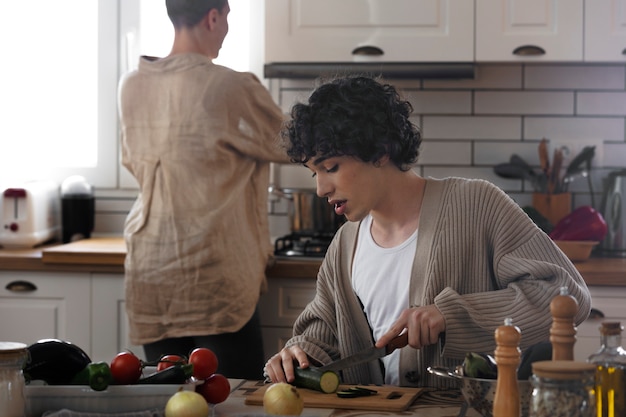Ah, food. The great unifier, the source of countless happy memories, and, sometimes, the root of a little marital tension. It’s true, isn’t it? food preferences, those seemingly innocuous little quirks about what we like and dislike, can sometimes become a source of conflict. I know, I’ve been there. I once spent a good chunk of our honeymoon arguing with my husband over whether or not to order the fish and chips (he wanted to, I didn’t). It wasn't the most romantic start to our married life, but it taught me a valuable lesson: effective communication is key when it comes to food, and honestly, most things in a relationship.
So, how do we navigate the minefield of food preferences and avoid those potentially awkward dinner table moments? This is what I’ve learned over the years, through trial and error, and a few gentle (and not-so-gentle) discussions with my husband:
(Part 1) The Foundation of Food Harmony: Understanding

Understanding Your Own Food Preferences: A Journey of Self-Discovery
The first step in this journey? Understanding yourself, my dear. It might sound obvious, but honestly, how often do we really stop and think about why we love a particular dish or why we avoid another? Take a moment to reflect. What are the things you really enjoy eating? What are the foods you find truly satisfying? Do you have any dietary restrictions or allergies? Knowing this is crucial in communicating effectively, as it allows you to articulate your preferences with clarity and confidence.
Think of it this way: your food preferences are like a map of your culinary landscape. They reveal your history, your cultural influences, and even your deepest desires. For example, my love for spicy food stems from my childhood memories of vibrant Indian cuisine. It’s a taste of home, a reminder of family gatherings, and a connection to my cultural heritage. Understanding where your preferences come from will help you communicate them with more depth and authenticity.
Understanding Your Spouse's Food Preferences: A Window into Their World
It’s all well and good to be mindful of your own preferences, but what about your beloved? Here’s where the magic of communication comes in! Start a conversation, a genuine one. Ask open-ended questions.
- “What are some of your favourite meals? What makes them special?”
- “What are some dishes you absolutely love? What memories do they evoke?”
- “Are there any foods you particularly dislike? Why do you avoid them?”
- “Are there any ingredients you’d rather avoid? Do you have any allergies or sensitivities?”
- “What are your go-to comfort foods? What makes them so comforting?”
You might be surprised by what you learn! It's a good opportunity to delve into each other's culinary histories, discovering how your backgrounds and experiences have shaped your food preferences. For example, my husband, a man of simple tastes, finds great joy in a plate of sausages and mash, a dish that reminds him of his childhood. As for me, I'm a bit more adventurous, always up for trying new cuisines and flavours. Understanding these differences allows us to appreciate each other's food preferences and find common ground. It’s a beautiful thing to understand the connection between food and personal history.
(Part 2) Communicating Effectively: The Art of Conversation

The Power of Open and Honest Dialogue: Breaking Down Barriers
Once you’ve got a handle on your food preferences and those of your partner, it’s time to start talking! Yes, it’s as simple as that. Open, honest communication is the cornerstone of a happy and healthy relationship, and this is especially true when it comes to food. Forget the passive-aggressive sighs and the silent sulking – let’s be clear and direct.
The goal is to create a space where you can both freely express your preferences without fear of judgment or criticism. It’s about establishing a shared understanding and respect for each other’s culinary desires.
Sharing Your Thoughts with Kindness: The Language of Love
It's all about expressing your preferences in a way that is both respectful and constructive. Avoid using accusatory language or making your partner feel as though they’ve done something wrong. Instead, focus on your own feelings and preferences. For example, instead of saying, “You always make the same boring food!” Try something like, “I would love to explore some new recipes together. I’ve been wanting to try [mention a specific cuisine or dish], would you be interested in giving it a go?”
Remember, the goal is to create a sense of collaboration and shared exploration, not to create a sense of tension or resentment.
Active Listening: The Crucial Other Side of the Conversation
Remember, communication is a two-way street. So, once you’ve shared your thoughts, it’s time to listen – truly listen – to your spouse. What are their preferences? What are their concerns? What dishes do they particularly enjoy?
Remember, active listening isn’t just about hearing words. It’s about engaging with the other person, asking clarifying questions, and acknowledging their feelings.
For example, if my husband expresses his love for a particular comfort food (like, say, a good old-fashioned shepherd’s pie), I try to understand why he enjoys it so much. Is it a taste of nostalgia? Is it the warm and comforting feeling it evokes? Understanding his reasons helps me appreciate his preferences even if they don't always align with mine.
(Part 3) Finding Common Ground: A culinary compromise

A Menu for Two: The Art of Compromise
Here comes the fun part. We’ve understood each other, we’ve communicated effectively, and now it’s time to find that sweet spot – the culinary compromise. It’s about finding a middle ground, where both your preferences are met, without anyone feeling like they’re constantly sacrificing their culinary desires.
Creating a shared meal plan: A Collaborative Approach
One way to achieve this harmony is to create a shared meal plan. Plan your meals together. Look through cookbooks, explore new recipes online, and discuss the dishes you’d both like to try.
For example, we have a system where we alternate cooking nights. One night, I might cook something a bit more exotic, and the next night, he might make his beloved sausages and mash. This way, we get to indulge in our own preferences while also trying something new. It’s a simple system, but it works wonders.
The Importance of Variety: Expanding Culinary Horizons
Another important aspect of culinary compromise is variety. Don’t fall into the trap of eating the same things week after week. Spice things up with new recipes, experiment with different cuisines, and occasionally, try something completely out of your comfort zone.
Remember, there’s a whole world of food out there waiting to be explored. For example, we have a tradition of trying one new restaurant a month. It’s a fun way to broaden our culinary horizons and discover new flavours together.
(Part 4) Making Mealtimes Fun: Embracing the culinary adventure
Turning Mealtimes into Moments to Cherish: Creating Memories
Food should be a source of joy, not stress. Think of mealtimes as opportunities to connect, to laugh, and to share stories. Remember, it’s not just about the food itself; it’s about the company and the memories you create together.
Embracing the Unexpected: Stepping Outside Your Comfort Zone
Be open to trying new things. Embrace the unexpected. Sometimes, the most delicious experiences come from venturing outside your culinary comfort zone.
One of my favourite memories involves a spontaneous trip to a Moroccan restaurant. I was hesitant at first, but my husband insisted we try it. And guess what? I fell in love with the vibrant flavours and the exotic spices. It was a culinary adventure that we’ll never forget.
Sharing Your culinary skills: A Language of Love
Cooking is a wonderful way to express love and care. Don’t be afraid to share your culinary skills with your spouse. Teach them some of your favourite recipes, and let them teach you theirs.
For example, my husband is a master of the grill, so I often ask him to teach me his secrets. It’s a fun way to bond and learn something new together. It’s also a lovely way to show appreciation for their skills and talents.
(Part 5) Food Preferences: A Window into Your Hearts
Discovering What Makes Your Spouse Tick: Unveiling Their Passions
Think of your spouse's food preferences as a window into their heart. They reveal their deepest desires, their memories, and their cultural heritage. For example, my husband’s love for simple dishes like sausages and mash reflects his humble upbringing and his appreciation for comfort food.
Respecting Each Other's Culinary History: Honoring Their Roots
Food preferences are often deeply personal and rooted in our individual experiences. So, show respect for your spouse’s culinary history. Ask them about their favourite meals from their childhood, the dishes that remind them of their family, and the cuisines that evoke fond memories.
These conversations can be incredibly revealing and intimate. They offer a glimpse into their past and help you understand the deeper meaning behind their food choices.
Building a culinary legacy: Sharing Your Journey
As you share your love of food with each other, you’ll build a culinary legacy – a collection of shared meals, cherished recipes, and happy memories. This legacy will grow stronger with each passing year, becoming a testament to the enduring bond you share.
Think of it as a shared culinary adventure, a tapestry woven with threads of your individual experiences and blended into something unique and special.
(Part 6) Navigating the Challenges: Finding Solutions
Addressing Dietary Restrictions: Finding Ways to Adapt
Let’s face it, life throws curveballs. Sometimes, dietary restrictions or allergies can complicate things. But don’t despair! This is where communication really comes in handy.
Be open and honest about any restrictions you or your spouse may have. Together, explore different recipes and dining options that cater to your needs.
Making Adjustments: A Collaborative Effort
Flexibility is key. Be willing to adjust your own preferences or make compromises when necessary. Remember, it’s about finding a way to enjoy meals together, even when there are challenges.
The Power of Technology: Harnessing Resources
Don’t underestimate the power of technology! There are countless websites and apps dedicated to helping people with dietary restrictions find recipes and dining options.
For example, my husband has a gluten intolerance, and we’ve found several apps that offer a wealth of gluten-free recipes. It’s a great resource for exploring new culinary possibilities and finding delicious options that suit our needs.
(Part 7) When Conflict Arises: A Guide to Resolving Disputes
Keep Calm and Communicate: Navigating the Rough Patches
Even the most loving couples may encounter moments of conflict when it comes to food. It’s important to approach these situations with patience, understanding, and a willingness to compromise.
Avoid blaming or making accusations. Instead, focus on expressing your feelings and needs in a calm and respectful manner. For instance, instead of saying "You always make this terrible dish", try "I'm feeling a bit overwhelmed with this meal. Would you be open to trying something different next time?"
Active Listening: The Key to Resolution
Remember the importance of active listening. Listen to your spouse’s perspective. Try to understand their point of view, even if you don’t agree with it.
Finding Solutions Together: Building a Better Future
Once you've both had a chance to express your thoughts and feelings, work together to find a solution. Be open to compromises. Seek common ground.
Remember, it’s not about winning or losing; it’s about finding a solution that works for both of you. Ultimately, you're on the same team, striving for culinary harmony and a happy, healthy relationship.
(Part 8) Beyond the Plate: Food as a Language of Love
Sharing Meals, Sharing Lives: The Bonds of Food
Food is more than just sustenance. It’s a way to express love, care, and affection. It’s a way to connect with those we love on a deeper level.
Creating Memories Through Food: Weaving a Culinary Tapestry
Through shared meals, we create memories that will last a lifetime. Think of all the special occasions you’ve celebrated with food: birthday dinners, holiday feasts, and romantic evenings.
These culinary moments become anchors in our memory, reminding us of the love, laughter, and shared experiences that make life so precious.
The Enduring Power of Food: A Lasting Connection
Food has the power to bring people together, to foster relationships, and to create lasting bonds. So, use it wisely. Use it to nourish your love, to strengthen your connection, and to build a life filled with shared joy and delicious experiences.
Remember, when it comes to food, it’s not about winning or losing, it’s about connecting, understanding, and creating a shared culinary journey that makes your relationship stronger and more fulfilling.
FAQs
| What if my spouse doesn’t like to try new things? | It’s perfectly okay for your spouse to have their comfort foods and their preferences. The key is to be patient and understanding. Instead of trying to force them to eat something they don’t like, try introducing them to new cuisines gradually. Start with a dish that has familiar flavours and textures, and then slowly introduce them to new ingredients and spices. Remember, it's a journey, not a race! You could even try incorporating their favorite flavors into a new dish, making it a bit more familiar. |
|---|---|
| What if we have different budgets for food? | Money can be a sensitive topic in any relationship. The best approach is to be open and honest about your financial situation. Discuss your budget together, and find ways to make it work for both of you. It’s also helpful to plan meals ahead of time, as this can help you to stick to your budget and avoid impulse purchases. Consider creating a weekly menu together that incorporates both affordable and indulgent options. |
| How do we handle food cravings? | Cravings are perfectly normal. We all have them! The key is to find healthy ways to satisfy them. If your spouse has a craving for something unhealthy, encourage them to try a healthier version of that dish. For example, instead of a greasy burger, you could make a healthier turkey burger. Sometimes, just a small portion of the craving can satisfy it. You could also plan a "cheat meal" once a week to indulge in those cravings while maintaining a balanced diet overall. |
| What if my spouse constantly complains about the food? | If your spouse is constantly complaining about the food, it's important to address the issue directly. Talk to them about how their comments make you feel. Try to understand what's behind their complaints. Are they genuinely unhappy with the food, or is there something else going on? Remember, constructive criticism can be helpful, but constant negativity can be hurtful. You can try suggesting a compromise, like taking turns cooking or trying new recipes together. |
| How can we make mealtimes more enjoyable? | Create a relaxed and enjoyable atmosphere. Turn off the TV and put away your phones. Focus on each other’s company and enjoy the conversation. Make it a habit to share stories, talk about your day, and appreciate the meal together. Mealtimes are an opportunity to connect and build a stronger bond. You could also try setting the table with a nice tablecloth and candles for a more romantic and intimate atmosphere. |
Everyone is watching

Prime Rib Roast Cooking Time Chart: Per Pound Guide
Cooking TipsPrime rib roast. Just the name conjures images of lavish dinners, crackling fires, and hearty laughter. It’s ...

How Long to Bake Potatoes in the Oven (Perfect Every Time)
Cooking TipsBaked potatoes are a staple in my kitchen. They're incredibly versatile, delicious, and surprisingly easy to m...

Perfect Rice Every Time: The Ultimate Guide to Cooking Rice
Cooking TipsAs a self-proclaimed foodie, I've always been a bit obsessed with rice. It's the foundation of countless cuisi...

The Ultimate Guide to Cooking Asparagus: Tips, Techniques, and Recipes
Cooking TipsAsparagus. The mere mention of this spring delicacy conjures up images of vibrant green spears, crisp and burs...

Ultimate Guide to Cooking the Perfect Thanksgiving Turkey
Cooking TipsThanksgiving. Just the word conjures up images of overflowing tables laden with delicious food, the scent of r...
